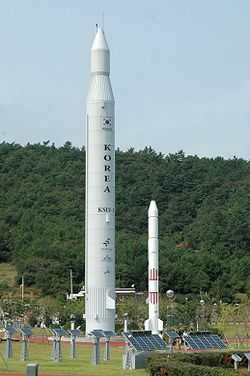Korea Aerospace Research Institute
 | |
| Acronym | KARI |
|---|---|
| Owner | South Korea |
| Established | October 10, 1989 |
| Headquarters |
169 - 84 Gwahak-ro, Yuseong-gu, Daejeon, South Korea |
| Primary spaceport | Naro Space Center |
| Motto | Aerius Spatium [1] |
| Administrator | Seung Jo Kim (김승조) |
| Budget |
₩ 453 billion (US$ 443 million ) 2014)[2] |
| Website | http://www.kari.re.kr/ |
|
Seal of KARI | |
| Korea Aerospace Research Institute | |
| Hangul | 한국항공우주연구원 |
|---|---|
| Hanja | 韓國航空宇宙硏究院 |
| Revised Romanization | Han-guk Hanggong Uju Yeon-guwon |
| McCune–Reischauer | Han'guk Hanggong Uju Yǒn'guwǒn |
The Korea Aerospace Research Institute (KARI) is the aeronautics and space agency of South Korea. Its main laboratories are located in Daejeon, in the Daedeok Science Town. Current projects include the KSLV-2 launcher. Past projects include the 1999 Arirang-1 satellite. The agency was founded in 1989. Prior to South Korea's entry into the IAE in 1992, it focused primarily on aerospace technology.
Background
South Korea first gained experience with missiles provided by the United States to counter North Korea.
KARI began in 1990 to develop its own rockets. It produced the KSR-I and KSR-II, one and two-stage rockets in the early 1990s.
In December 1997 it began development of a LOX/kerosene rocket engine. KARI wished to develop satellite launch capability. A test launch of the KSR-III took place in 2002.
KARI had a 2003 budget of 156.4 billion won ($150 million USD).
History
- 1989.10 Establishment of KARI affiliated to KIMM(Korea Institute of Machinery & Materials)
- 1990.12 Cornerstone - Laying ceremony for the building of the institute
- 1992.07 Authorized as the Inspection Agency, designated by the AIDP Law
- 1992.11 Completion of construction of the research building complex
- 1996.11 Independent organization as KARI, an Incorporated Foundation
- 1997.04 Authorized as the Type Certification Agency, designated by the Aviation Law
- 1999.01 Change of Type Certification Agency
- 2001.01 Change of name to Korea Aerospace Research Institute
- 2003.05 Cornerstone - laying ceremony for the Aircraft Flight Test Center
- 2003.08 Cornerstone - laying ceremony for the NARO Space Center
- 2004.10 Completion of JEJU island Tracking Station
- 2005.01 Installation of South pole ground station
- 2008.03 Transfer to KRCF(Korea Research Council of Fundamental Science o& Technology
- 2009.06 Completion of NARO Space center
Aerospace developments
.jpg)

KARI is also developing Unmanned Aerial Vehicles, high-altitude airships, and a next-generation multi-purpose helicopter project. In addition, several satellites, including the KOMPSAT (also known as Arirang) Seriese, the COMS (Communication, Ocean and Meteorological Satellite), and the STSAT (Science and Technology Satellite), are developed, operated, or under development by KARI. On January 30, 2013, they launched a satellite into space from their own soil for the first time.[3]
Mission and Major Functions
- Perform basic and applied studies in aerospace technology
- Development of leading-edge technology aircraft, aircraft evaluation and testing, and support of national development projects
- Research and development and Launching of artificial satellites, and development of technology for satellites applications
- Development and KSLV(Korea Launching of Space Launch Vehicles) and Operation of Space Center
- Perform government-delegated tasks and support policy development
- Development of technology for assuring aerospace safety and quality, and maintenance of legal quality certification and internationally recognized certification systems
- Establishment and support of the National Aerospace Development Policy and dissemination of knowledge on aerospace technology
- Support industries and transfer technology
- Joint utilization of testing facilities and equipment with industries and academia, and training of scientists and engineers
- Transfer of technology from research and development and provisions for commercialization support
KSLV-2
South Korea is planning to launch its next rocket KSLV-2 by year 2019. The first stage of its rocket will have 4 clustered engines, each of which will have a 75 metric ton thrust. It was announced that KARI has already developed few prototypes of a 75 metric ton thrust engine.
Smart Tilt Rotor UAV
In late 2011, KARI unveiled it tiltrotor Unmanned Aerial Vehicle (UAV) that can fly at around 400 km/hr. This was the world's first tilt rotor UAV to have been developed.
See also
- Naro Space Center
- Korean Astronaut Program
- List of aircraft manufacturers
- List of Korea-related topics
- Government of South Korea
- NEASS
- Naro-1
References
- ↑ Latin for "Aerospace"
- ↑ "기관별 경영공시 한국항공우주연구원". alio.go.kr. Retrieved 2014-08-10.
- ↑ "South Korea launches rocket weeks after NKorea". The San Diego Union-Tribune. January 30, 2013. Retrieved 2013-02-01.
External links
- KARI official website (Korean / English)
- South Korean space projects from Encyclopedia Astronautica
- KSLV
| ||||||||||||||||||||||||||
| ||||||||||||||||||||||||||||||||||||||||||||||||||||||||||||
